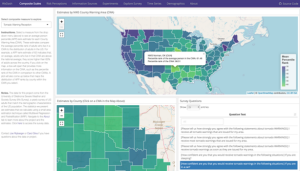Researchers at the University of Oklahoma’s National Institute for Risk and Resilience, Cooperative Institute for Mesoscale Meteorological Studies, and the National Severe Storms Lab recently conducted a transdisciplinary experiment exploring the effect of social and behavioral data on how weather forecasters communicate risk before, during, and after extreme weather events.
Makenzie Krocak, a research scientist at NIRR, and Kim Klockow McClain, a research scientist at CIMMS/NSSL, led the experiment. They walked forecasters through a range of forecast and risk communication exercises, asking them to create mock products, like Facebook posts, videos, posters, and briefs to emergency managers, to convey risk as a tornado event unfolds in two very different county warning areas: Des Moines, Iowa and Columbia, South Carolina. The forecasters used information from the database of community statistics and interactive platform when making decisions about how to communicate risk in the different parts of the country. The experiment was conducted virtually in NOAA’s Hazardous Weather Testbed, a joint project of the National Weather Service and the NSSL.
“In the HWT, researchers and forecasters work side-by-side to evaluate emerging research concepts and tools in settings that closely mimic forecast and warning operations,” Krocak said. “Interaction in this environment gives forecasters direct access to state of the art research developments and provides the scientists responsible for these developments in situ feedback on the applicability and utility of the research to forecasters. This collaborative approach enables a highly effective, two-way path between research and operations that ultimately improves weather forecasts and warnings.”
Analysis of the experimental data is currently underway, but Krocak said early results clearly indicate the utility and importance of this type of information to risk communication for weather events.
“All of the forecasters agreed that the information in the database and on the platform changed the way they think about risk communication and that they are very likely to use the tools and share them with others when they return to work,” sadi Joseph Ripberger, deputy director for research at NIRR. “Just as important, the forecasters provided considerable feedback to our research team on the type of information they would like to see in the database and how to increase the usability of the interactive platform and we’re already working to implement these changes.”
Ripberger added that historically, HTW experiments have focused on research developments in the physical sciences, such as the development of new radar technology and numerical weather models. This most recent experiment was among the first to focus on research developments in the social and behavioral sciences. This experiment builds on database of community statistics and an interactive platform about a variety of factors known to influence public responses to forecasts and warnings, such as warning reception and comprehension that researchers began developing in 2017.
Carol Silva, director of the Center for Risk and Crisis Management and co-director of the NIRR said, “Experiments like this demonstrate the value of transdisciplinary research and the co-production of science and technology. The diversity of the research team and forecasters involved in the experiment led to wide ranging conversations that would not have been possible in disciplinary or professional silos.”

